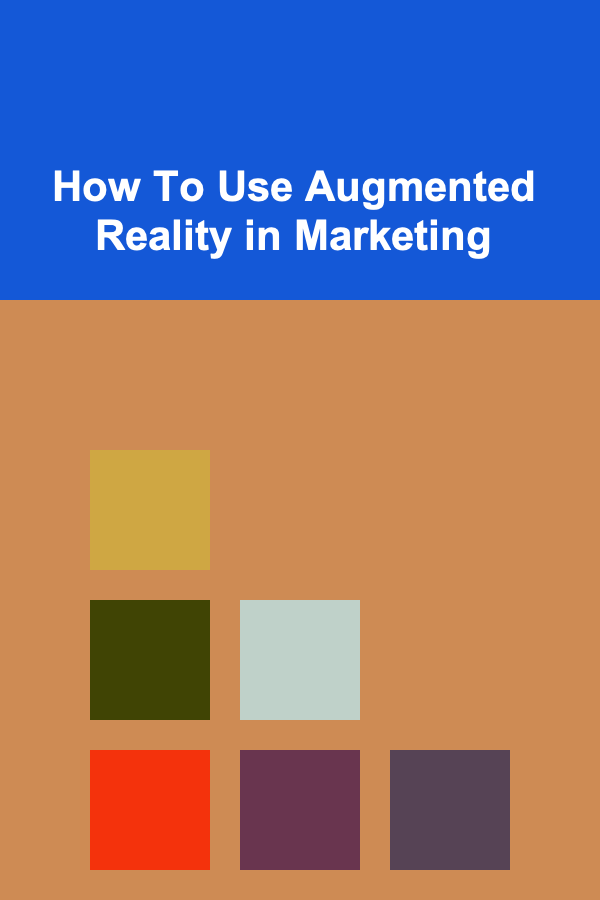
How To Use Augmented Reality in Marketing
ebook include PDF & Audio bundle (Micro Guide)
$12.99$11.99
Limited Time Offer! Order within the next:

Augmented Reality (AR) is no longer just a futuristic concept; it's a transformative tool that has rapidly found its way into the world of marketing. By blending the physical and digital worlds, AR offers new ways for brands to engage with consumers, provide interactive experiences, and drive marketing success. In this article, we will explore how marketers can effectively leverage AR technology, delve into its applications, examine case studies, and outline best practices to make the most of this cutting-edge technology.
The Basics of Augmented Reality (AR)
Before diving into its marketing applications, it's important to understand what AR is and how it works. Augmented Reality involves overlaying digital content, such as images, videos, or sounds, onto the real world through a device like a smartphone, tablet, or AR glasses. Unlike Virtual Reality (VR), which creates a completely immersive environment, AR enhances the real world by adding digital elements that interact with the user's surroundings in real-time.
The growing accessibility of smartphones with AR-capable cameras, along with advancements in software, has made AR an increasingly feasible and cost-effective tool for businesses to integrate into their marketing strategies.
Why Use AR in Marketing?
The use of AR in marketing offers brands an unprecedented opportunity to engage customers in a more interactive and personalized way. It allows businesses to create experiences that are more engaging, memorable, and shareable. Here are several key benefits of using AR in marketing:
- Increased Engagement: AR provides an immersive experience that captures the attention of consumers more effectively than traditional advertising methods. Interactive experiences invite users to engage with a brand or product in a way that is fun and educational, increasing the likelihood of sharing and repeat interaction.
- Personalized Customer Experiences: AR allows companies to tailor experiences based on a user's preferences or behavior. For instance, a customer can virtually try on clothes or makeup, creating a highly personalized shopping experience that mirrors the real-world decision-making process.
- Enhanced Storytelling: Through AR, brands can tell a compelling and multi-dimensional story. Instead of just reading about a product, consumers can see it in action, interact with it, and experience its features in a more immersive way.
- Improved Brand Recall: AR experiences are typically memorable and shareable, which increases the chances that consumers will recall the brand later. The novelty of AR combined with a seamless user experience can help a brand stand out in the competitive marketplace.
- Increased Sales and Conversion Rates: By providing consumers with the tools to visualize products in a real-world context, AR can help eliminate purchasing barriers and reduce the uncertainty associated with buying online. As a result, AR can lead to higher conversion rates and sales.
How AR Can Be Used in Marketing
There are several innovative ways to integrate AR into marketing strategies. Below, we will explore some of the most effective applications:
1. Virtual Product Try-Ons
One of the most popular applications of AR in marketing is virtual product try-ons. This is especially relevant in the retail, fashion, beauty, and home décor industries. Virtual try-ons allow customers to visualize how a product will look on them or in their space without physically interacting with it. For example, makeup brands like Sephora have integrated AR into their mobile apps, allowing users to "try on" makeup virtually through their phone's camera. Similarly, IKEA's app enables customers to place 3D models of furniture in their homes to see how they would fit into their existing space.
Why It Works: Virtual try-ons enhance the shopping experience by providing a better sense of fit, style, and color without needing to visit a store or try on physical products. This increases consumer confidence, reduces return rates, and helps businesses capture a more significant share of the market.
2. AR-Enabled Advertising Campaigns
AR can transform traditional advertising campaigns by adding interactivity. Instead of just watching an ad, consumers can engage with it in real-time, which helps brands stand out from the clutter of conventional marketing. One example is interactive print ads that come to life when scanned with a smartphone or tablet. These ads might show a 3D model of a product, provide additional content such as videos, or direct the user to a special offer.
Why It Works: AR-enabled ads provide a deeper level of engagement, allowing users to interact with content in a more immersive way. This interaction can lead to higher retention, increased brand recall, and a better overall consumer experience.
3. AR in Social Media Marketing
Social media platforms are increasingly adopting AR technology to enhance user-generated content and brand engagement. Snapchat and Instagram, for example, have become popular platforms for brands to create AR filters, allowing users to apply virtual effects, add 3D models, or interact with branded content in creative ways.
Why It Works: Social media is all about engagement and sharing, and AR is a powerful tool for creating shareable, fun, and interactive experiences. By giving users the ability to play with branded filters, businesses can significantly increase brand visibility and engagement on platforms where visual content is king.
4. AR for Location-Based Marketing
AR can also enhance location-based marketing efforts by allowing brands to interact with consumers in specific real-world environments. For example, AR-enabled apps can provide consumers with information about nearby stores, promotions, or even historical facts and landmarks when they point their devices at certain objects or locations.
Why It Works: Location-based AR enhances the customer's real-world experience by integrating relevant digital content with their physical surroundings. This creates opportunities for businesses to drive foot traffic to stores, increase local engagement, and offer location-specific promotions or discounts.
5. AR for Interactive Packaging
Packaging is a critical touchpoint in the consumer experience, and brands can use AR to make it more interactive and engaging. By embedding AR features into product packaging, businesses can provide customers with additional content such as instructional videos, user manuals, or even the history of the brand. For instance, some beverage companies have used AR to turn product labels into interactive experiences that provide consumers with a fun, informative, or entertaining way to engage with the product.
Why It Works: Interactive packaging can turn an ordinary product into a memorable experience. By adding value to the packaging, brands can increase consumer interest, boost brand loyalty, and provide valuable information that can influence purchase decisions.
6. AR for Trade Shows and Events
Trade shows, expos, and product launch events are prime opportunities for AR to shine. AR can enhance physical displays by allowing attendees to interact with 3D models of products, see virtual demonstrations, or experience immersive brand storytelling. For example, instead of just watching a product demo, attendees could use AR glasses or apps to interact with the product or visualize its potential uses in real-time.
Why It Works: AR can turn a standard trade show experience into an immersive and engaging event. By offering interactive and personalized experiences, brands can leave a lasting impression on potential clients and partners.
7. AR for Consumer Education
Educating consumers about products, services, or processes can be made much more engaging and informative with AR. For instance, AR can be used in tutorials or "how-to" guides that help consumers understand how to use a product or navigate a service. Car manufacturers like Porsche have used AR to create detailed, 3D visualizations of their vehicles' features, enabling customers to explore the car's features from every angle.
Why It Works: AR makes learning more engaging by providing hands-on, interactive experiences that are easier to understand than traditional text or video tutorials. This improves customer satisfaction, reduces confusion, and increases the likelihood of customers using products correctly.
Successful Case Studies of AR in Marketing
1. IKEA's "IKEA Place" App
IKEA's "IKEA Place" app is one of the most notable examples of how AR is transforming the retail experience. The app allows users to visualize how IKEA furniture would look in their own homes, using their phone's camera to place 3D models of the furniture in real-time. This tool helps customers make more informed purchase decisions by allowing them to see how the items will fit and look in their actual space.
Result: IKEA's AR app has proven to reduce uncertainty and improve the shopping experience, leading to higher customer satisfaction and increased sales.
2. L'Oreal's AR Beauty Try-On
Cosmetics brand L'Oréal has embraced AR through its "ModiFace" AR technology, which allows users to virtually try on makeup products through their smartphones. The technology overlays makeup products onto the user's face in real-time, enabling them to experiment with different shades and styles before making a purchase.
Result: L'Oreal's AR-driven marketing campaign has helped them drive both online and in-store sales while offering a fun and interactive experience that encourages repeat engagement.
Best Practices for Implementing AR in Marketing
While the potential for AR in marketing is immense, businesses must approach its implementation strategically. Here are some best practices to consider when incorporating AR into your marketing efforts:
- Ensure a Seamless User Experience: The AR experience should be easy to access and use. Complicated or clunky technology can frustrate users and turn them off from engaging with the brand.
- Focus on Value: Ensure that the AR experience provides real value to the consumer. Whether it's through enhancing the shopping experience, offering useful information, or delivering entertainment, consumers should feel like they gain something from the interaction.
- Keep it Relevant: Make sure the AR experience aligns with your brand and message. The content should be relevant to your product or service and designed to enhance the consumer's understanding or experience with your brand.
- Test and Optimize: Like any other marketing initiative, AR campaigns should be tested and optimized for performance. Collect feedback from users, track metrics, and refine your AR experiences to ensure maximum effectiveness.
Conclusion
Augmented Reality is a powerful tool that can revolutionize the way brands connect with their customers. By offering immersive, interactive, and personalized experiences, AR can enhance engagement, increase sales, and create lasting brand loyalty. However, to fully capitalize on AR's potential in marketing, businesses must focus on providing value, maintaining relevance, and delivering a seamless user experience. As AR technology continues to evolve, its role in marketing will only grow, offering new and exciting possibilities for brands to explore.

How to Build a Healthy Gaming Lifestyle
Read More
How to Maintain Your Home's Water Heater for Efficiency and Longevity
Read More
How to Run a YouTube Giveaway to Increase Engagement and Sales for Your Dropshipping Store
Read More
How to Write Stand-Up Comedy Jokes That Actually Land
Read More
How to Build a Loyal Fanbase as an Indie Musician
Read More
10 Tips for Ethical Tarot Readings
Read MoreOther Products

How to Build a Healthy Gaming Lifestyle
Read More
How to Maintain Your Home's Water Heater for Efficiency and Longevity
Read More
How to Run a YouTube Giveaway to Increase Engagement and Sales for Your Dropshipping Store
Read More
How to Write Stand-Up Comedy Jokes That Actually Land
Read More
How to Build a Loyal Fanbase as an Indie Musician
Read More